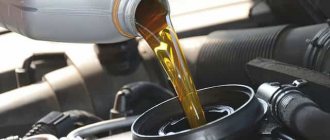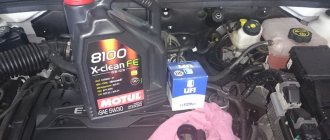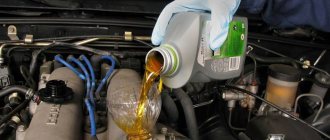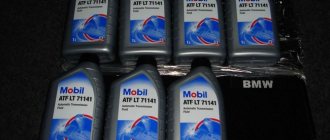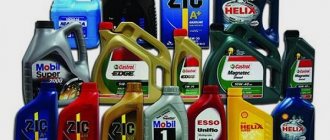It happens that when using a machine equipped with a diesel engine, the amount of lubricant does not decrease, but increases. Increased oil costs are a very common problem. Someday it occurs in almost any car.
The opposite problem - an increase in the oil level in the engine - requires careful diagnosis, probably the replacement of certain spare parts. The lubricant level is set using a dipstick.
How to choose an oil fluid
Every automotive component needs lubrication. It reduces friction between contacting parts. In order for the oil to provide high-quality lubrication of parts, it is necessary to follow the rules for its selection.
First of all, the car oil must be of high quality. Low-quality petroleum products do not perform their task well and clog the power unit. Interacting with engine parts, the lubricant eventually forms carbon deposits that clog the holes and prevent the engine from working properly. In view of this, you should not pour cheap consumables into the engine.
Operating temperature range of motor oils
Also, the oil must be suitable for the internal combustion engine. With an optimal viscosity index, the engine will be able to work as efficiently as possible. The same oil fluids can be poured into gasoline and diesel internal combustion engines. This is due to the identity of the processes that take place in them. However, the different composition of the fuel should be taken into account.
All spare parts must be undamaged and in working condition. Small cracks lead to disruption of the correct operation of the engine. The characteristics of the petroleum product are deteriorating. Particles are formed that affect the efficiency of the internal combustion engine.
By promptly filling the engine with optimal lubricant, it is possible to prevent the occurrence of malfunctions that are associated with a decrease/increase in the oil fluid level.
Increased consumption due to grease burning
Another reason why engine lubricant consumption increases is lubricant combustion. It can occur in the manifold or air filter during operation of the crankcase ventilation system. Combustion occurs due to too high pressure in the crankcase. To eliminate this problem, you should check its piston and ventilation systems.
In some cases, the problem may be in the valve sleeve or valve stem seals. In order to determine this, you need to accelerate the engine to 4000 rpm and pay attention to the color and intensity of the exhaust. If the exhaust gases become more saturated in color or even black, then the caps need to be replaced.
Often the turbine is to blame
To check whether the lubricant is leaving the motor, you can do the following:
The presence of problems with the caps is indicated by a thick smoky cloud that flies out during a sharp start.
If a sharp increase in oil consumption is accompanied by a noticeable increase in compression, and the engine begins to smoke at high speeds, the oil may be burning through the rings. Sometimes the reason is that the rings are stuck due to carbon deposits. You can try to solve the problem by soaking them.
How to determine that the volume of motor lubrication is increased
When checking the oil fluid, you will notice that its amount has increased compared to the previous check. There is nothing good about this. This means that impurities are formed during the operation of the motor oil. What does this mean?
The composition of any lubricant, be it synthetic or mineral, includes certain additives aimed at increasing its characteristics and improving the functioning of the engine. Automakers have worked hard to perfect the formulas and therefore the petroleum products. They created the highest quality elements to ensure smooth and efficient operation of the engine. When foreign particles get into the oil, you can observe the following:
- blue exhaust gases;
- change in the shade of the lubricant;
- specific smell of oil.
Functions of motor oil in an engine
These are only part of the signs by which it is possible to determine the presence of foreign elements in an oil product. In view of this, if a special dipstick shows an increase in the oil level in the engine, be sure to check the lubrication, try to neutralize the above signs when they are detected.
Lubricant loss due to leaks
One of the main reasons why lubricant quickly leaves the engine is a leak. Where can leakage occur and what should be done? The answers are in front of you.
- Valve cover: requires replacement or careful sealant treatment.
- Distributor - also treated with sealant.
- A mechanical fuel pump requires replacement of gaskets and sealing.
- The balancer shafts need to be replaced.
Chip for checking oil level
- Engine crankcase: to completely eliminate the leak, dismantling and leveling are required, followed by high-quality sealant treatment.
- The front and rear seals on the camshaft must be replaced.
- Oil sensors cannot be repaired, so the only option is replacement.
- You can try to tighten the oil filter or tighten it more tightly; if that doesn’t help, replace it.
- Cylinder head gaskets require urgent replacement.
- A leak in several places at the same time can only occur under high pressure, otherwise it will not be possible to detect it.
If your car has problems with crankcase ventilation, you must fix them. Otherwise, it will be quite difficult to detect a leak.
How does an increased amount of lubricant affect the functioning of the engine?
Is there any harm from the increased volume of motor oil? Undoubtedly. Different linings lose their elasticity, causing connections to break down. Even small leaks can greatly affect the performance of the engine.
Any flammable substance thinner than oil. Therefore, when mixed with the oil liquid, the fuel reduces its viscosity. As a result, lubricant drains from the contacting parts, and a protective film does not form. Parts rub against each other, their wear increases.
Consequences of incorrectly changing engine oil
Liquid lubricant can enter the combustion chamber, where fuel is converted into energy. As a result, specific smoke is released and power is partially lost. Soot appears and settles inside the combustion chamber and gas exhaust channels.
A change in the shade of the car oil is also considered a sign that the oil has risen in the internal combustion engine. For any engine, the automaker determines lubricant consumption rates and replacement intervals. There are special marks on a special dipstick for checking the volume of engine oil. It is from them that it is possible to determine that the oil is rising in the internal combustion engine.
Unnatural frenzy
The abnormal oil appetite of an engine with noticeable mileage is caused by wear of the cylinders, pistons and their rings, and valve seals. And if valve seals (oil seals) are, in principle, easy to replace, then replacing worn parts of the cylinder-piston group requires complete disassembly of the power unit - and this is serious work that requires qualifications from craftsmen and money from the owner.
Another option, even if the engine is not too worn out, is the so-called stuck rings. This means that due to carbon-clogged grooves in the piston, the rings lose mobility and do not fully perform their function, which is why a large amount of oil remains on the cylinder walls and burns. This problem can sometimes be solved by using flushing additives.
Recommendation Auto24
Before you take such a serious step as engine repair, rely on the opinion of a professional: after all, there is a difference between disassembling the engine and flushing it with an additive. Masters specializing in this brand of power units will most likely be able to tell you in advance the reason for the “gluttony”. So in this case, do not skimp on diagnostics.
When adding engine oil after a suspiciously sharp drop in the level, measure the amount added and record the odometer reading. The next time you top up, calculate the oil consumption per 1000 km.
Errors during maintenance
For what other reasons can the oil level in a diesel engine increase? Car oil may rise due to errors during maintenance. When the volume of lubricant being poured is too large, it is natural that its level will increase. If you poured just a little more than the top mark of the dipstick, that's okay. When using a car, the amount of lubricant will decrease.
However, if the overflow is too large, problems may arise. An increased amount of motor oil in the lubricating complex leads to increased compression. The seals wear out and become deformed. This applies to used cars in which all spare parts are already partially worn out.
Engine oil level
An increase in the level of lubrication leads to disruption of the functioning of the power unit. If you ignore this for a long time, the engine may break. You will have to overhaul it. In view of this, it is necessary to service the machine in a timely manner. The proper functioning of the car depends on this.
Increased lubricant consumption due to fuel ingress
The reasons that may result in diesel fuel getting into the lubricant are as follows:
- The load on the motor increases;
- Compression or piston rings begin to overheat;
- Worn cylinders;
- Liquid flows through the seals;
- The filter gasket is faulty.
In a diesel engine, leakage of fuel into the lubricant is a fairly common occurrence. The high degree of fluidity of diesel fuel dilutes the lubricating fluid, sharply reducing its viscosity level and preventing the formation of an oily film. Fuel does not evaporate as temperatures rise, and with each leak into the engine it becomes more and more, which leads to damage to the car’s power unit.
The oil loses viscosity, which entails a decrease in cylinder lubrication - as a result, wear of the piston rings occurs.
Replacing piston rings
The lubricant into which the fuel has penetrated has a significant negative impact on the wear resistance of the crankshaft liners. If you don’t start dealing with this problem in time, you can end up with a lot of hassle that will require a lot of time and money to solve.
Among the main reasons due to which fuel gets into the lubricant are wear of the adjustable valve pump, coked injectors, cold engine starts, and frequent idling of the power unit at high speeds.
Ways to solve the problem
Knowing approximately where the lubricant in the engine can disappear, you can consider the main ways to eliminate the problem. The first thing you should do is evaluate your driving style - it may be enough to simply take a gentler approach. Next, you should think about the quality of the lubricant being poured and its viscosity.
Manufacturers recommend filling most new engines with oil with a viscosity of W30. For older engines, it is better to use a substance with a viscosity of W40–W60. In the first case, care is provided for the catalytic converter and particulate filter. In the second, attention is drawn to the high consumption of lubricating fluid and insufficient compression.
When operating a car in Russian conditions, it would be most reasonable to fill in a lubricant with a summer viscosity index of 30 or 40. It is better to use such oils constantly. In this case, you should pay attention to the recommendations of the car manufacturer.
More radical ways to reduce lubricant consumption already relate to repair and maintenance work. Professionals do not recommend decoking the engine using special preparations. The use of such means is risky, since they can only help at the initial stage of piston ring jamming. But in order to find out the current state of the engine, you should disassemble it.
The next stage is replacing the valve stem seals, which are located on the intake and exhaust valves. This is the simplest and cheapest procedure, but it can only help when the working cuffs wear out and the material of the caps hardens. If the rod of the guide bushings and valves is worn out, it will be necessary to remove the cylinder head and replace the bushing and valve.
By removing the head, you can also inspect the cylinders. The presence of wear and tear on their walls in those places where the top dead center of the piston movement is located indicates the need for a major overhaul of the engine. If the engine is equipped with a turbine, you need to find out whether the turbocharger is the culprit for the high consumption of lubricant.
Rebuilding or replacing the engine is a separate matter. Moreover, for some engines, major repairs, including replacement of faulty parts and boring of the cylinder block, are not provided by the manufacturer. In this case, you should evaluate all the pros and cons, and also estimate the amount of costs for restoring the engine or replacing it.
Main reasons for overflow
When replacing engine fluid, you should check the manufacturer's recommendations for volume to prevent overflow. The value will be average: it all depends on how completely the old lubricant was drained. But in any case, following the factory’s instructions, you will keep the amount of oil within the required limits. Reasons for overflow:
- changing the oil on a cold engine: after warming up, as you know from a school physics course, bodies expand and the level of engine fluid will rise;
- topping up consumables when the machine is standing on an uneven place with a slope back or to the side;
- pouring motor fluid from an excessively large container: you may simply not calculate the required amount, especially if there are no marks on the canister;
- basic inattention;
- lack of tightness of the gas pump: as a result, the oil is mixed with fuel, and the lubricant level increases above normal. It’s easy to check: smell the dipstick, and if you smell fuel, start fixing the problem.
Another reason for increased pressure in the system is the use of oil that is not appropriate for the season. For example, if you use winter material in summer, at excessively low temperatures, an increase in volume due to reduced oil viscosity is quite possible.
Why does engine oil leak?
So, if the driver regularly monitors the lubrication level, then it will immediately be noticeable that the oil has left the engine. In this case, oil consumption is usually affected by two factors: engine oil leakage and oil burnout.
- Let's start with the most common reasons. For example, a breakdown of the cylinder block gasket occurs in the event of incorrect assembly of the engine and improper crimping of the cylinder head. The result is that the cylinder head is not evenly pressed against the cylinder block through the gasket, which leads to breakdowns in places where the cylinder head is loosened. The car owner can identify this malfunction with the naked eye by leaks of engine oil from under the cylinder head.
Also, a breakdown of the cylinder head gasket can also result in coolant entering the engine crankcase. In this case, this will be signaled by the appearance of an emulsion in the oil sump. When removing the oil dipstick from the engine crankcase, you can observe an increase in the oil level and an uncharacteristic whitish tint for oil (emulsion).
Currently reading
Installation and repair of the muffler resonator
How often to change the timing belt on a car: what you need...
In this situation, under no circumstances should you start the engine, in order to avoid wear on the crankshaft liners, increased wear on the camshaft cams and scuffing on the mirror surface of the cylinder liners.
To solve the problem, it is better to deliver the vehicle by tow truck to the place of repair and replacement of the cylinder head gasket. It is also a mistake to believe that without replacing the gasket, additional tightening of the cylinder head will give results. The fact is that since the head gasket is already deformed, there will be oil leaks at the deformation sites.
A mandatory measure in this situation is to flush the lubricating lines from emulsion residues with flushing oil, after which the oil recommended by the engine manufacturer is poured into the engine.
For the information of car owners, motor oils of inexpensive brands, but with the appropriate viscosity coefficient, can be used as flushing oil. This will not cause any harm to the internal combustion engine, since the duration of operation of the engine on cheap oil is not significant, the loads are minimal, and the task of such a lubricant is to flush the engine from the emulsion. At the same time, savings on the car owner’s budget are obvious.
- Worn crankshaft oil seal (front or rear) is also a fairly common cause of engine oil leakage. This problem can sometimes be easily diagnosed by an oil puddle under the car or drips. However, in some cases, obvious leaks are not always visible without examining the lower part of the car.
The crankshaft oil seal is made of rubber, but it is not durable and is subject to various influences (elasticity is lost, wear appears, rubber is subject to mechanical wear by abrasive debris contained in engine oil, etc.). In this situation, the solution to the problem is obvious. The crankshaft oil seal needs to be replaced. It is also recommended to fill with fresh engine oil and change the oil filter.
- Oil leakage from under the oil filter gasket or from the oil filter housing is also on the list of possible causes for a decrease in the oil level in the engine crankcase. The problem arises as a result of incorrect installation of the oil filter (under-tightening or overtightening, as well as abrasive dust getting on the filter gasket). A factory defect in the oil filter is also possible (oil may leak in places where the filter housing is rolled).
The problem is solved by replacing the oil filter. If the filter is not tightened enough, then you need to try tightening it more. By the way, in order to avoid deformation of the rubber gasket of the oil filter, experts recommend lubricating this gasket with oil before installing it.
- Failure of oil seals (oil seals) can also lead to a drop in the oil level in the engine crankcase.
This part is made of oil-resistant rubber. Over time, under the influence of pressure and high temperatures, rubber loses its elasticity and, accordingly, ceases to function as a seal. We also recommend reading the article about why a diesel engine consumes oil. From this article you will learn about the causes of diesel engine oil consumption.
As a result, the tightness of the gas distribution mechanism valve seals is lost and the engine oil flowing through the leaky valve seals flows down the guides and enters the internal combustion engine cylinders. The lubricant then burns along with the fuel. Engine oil combustion products have a detrimental effect on the performance of piston parts. The problem can be resolved by replacing the valve stem seals.
- The occurrence of oil scraper rings leads to poor removal of the oil film from the inner surface of the cylinder during the piston stroke. As a result, the oil remaining in the combustion chamber actively burns out, forming coke deposits.
Such deposits lead to coking and ring formation. The result of this is a decrease in the compression level, a drop in the power of the internal combustion engine and uneven development of the working surface of the cylinders (ellipse), which entails expensive repairs with boring or lining the cylinder block, as well as the need to perform work to replace the piston rings.
Where does the engine oil go: hidden reasons
Let's start with the fact that in addition to the obvious reasons for increased lubricant consumption (oil leakage), there are also indirect ones. For example, an internal combustion engine cooling system.
In simple words, a number of malfunctions in the engine cooling system, insufficiently efficient operation of this system can also lead to the so-called “oil burn”.
The reason is that insufficient heat is removed from the engine, the engine in turn becomes “hotter”, i.e. its operating temperature is forcibly increased by several degrees and the internal combustion engine operates at the upper temperature limit.
The oil recommended for use in various engines, according to its technical characteristics and tolerances, is designed to operate at lower temperatures, namely at the nominal temperature conditions of the internal combustion engine.
Accordingly, being constantly exposed to extreme temperatures, the oil intensively “burns”, and the waste products clog the oil channels, reducing the efficiency of the entire engine lubrication system.
- Oddly enough, problems in the power system can also indirectly provoke increased engine oil consumption. The problem lies in the fuel injectors, which, without proper maintenance, over time begin not to spray the fuel mixture, ensuring uniform ignition in the cylinder, but pour fuel in a stream.
As a result, uneven combustion of fuel begins and increased detonation. In turn, increased detonation leads to the appearance of microcracks in the pistons and piston rings, as well as cylinders (liners). Due to these defects, oil scraper rings do not effectively remove the oil film from the working walls of the cylinders. It turns out that oil breaks into the combustion chamber with all the ensuing consequences.


